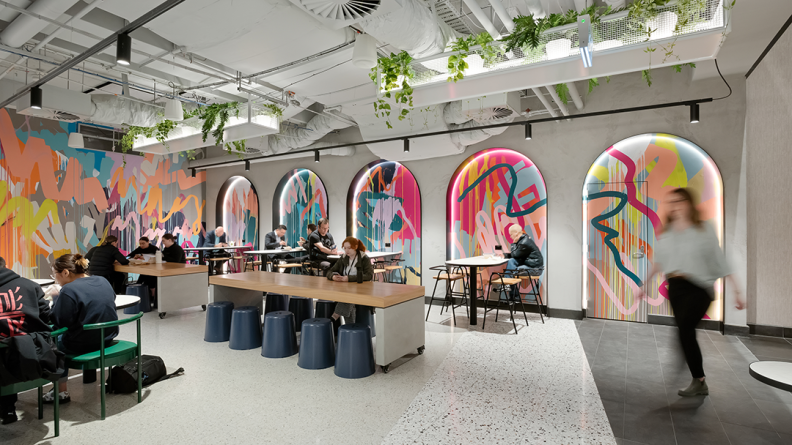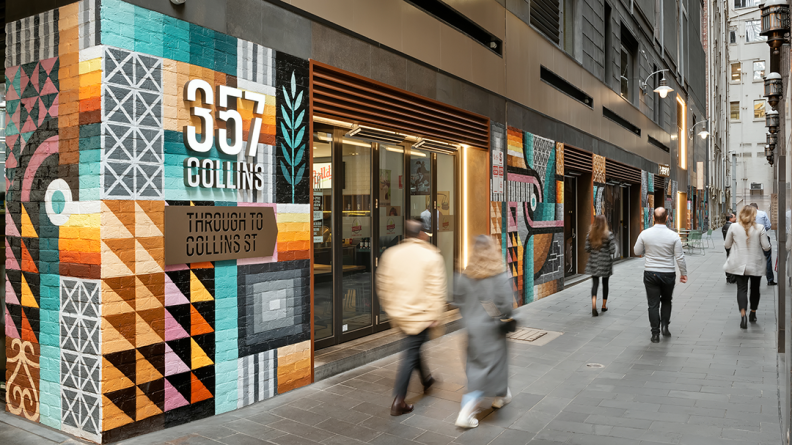We celebrated the beautifully curated space at 357 Collins Street last week with a special panel event called 'Culture Bites'. Harold Perks led an insightful panel discussion with Jo Mair from the City of Melbourne, and artists Rowena Martinich, Dixon Patten, and Mandy Nicholson.
The discussions touched on the value of language in creating authenticity in the public art realm, and the importance of ‘connection’ to bridge the gap between curiosity and understanding. Here are some of the insights gained from the evening.
As design facilitators, we draw inspiration from the world around us. We believe that design outcomes are stronger when we all work together, giving everyone a voice rather than designing in isolation. By applying this thinking to the public realm, the outcomes can be better than anyone expected – fresh spaces for people to find, discover, nurture, take care of and grow.
What can we learn from our experiences and how can our industry do this better?
Art as a layer
We commissioned artist Rowena Martinich to create unique artwork for the newly refurbished 357 Collins Food Hall. She responded with an explosion of colour comprising one large wraparound piece overlaid into illuminated arches, bringing to life the energy and vitality of people as they pass in and out of the building. Just beyond, multidisciplinary artist Beastman (Bradley Eastman) created a piece for Fulham Place.

The result is a reimagined Food Hall from what was a rundown restaurant, and the revitalising of an iconic Melbourne laneway. Their creative process is also captured on film screened on a wall within the space, illustrating how both artists drew on the context and own stories to create a new layer of meaning.
Connection through language
Creating meaning through context is also important for Indigenous artists Dixon Patten (Bayila Creative) and Mandy Nicholson (Tharangalk Art), who have created several commissions for Hames Sharley. But even this can be complex, as the many stories and layers in Indigenous culture can cloud the ability to create an authentic response. Their response, however, is to take people on a journey, finding a common theme that links their Indigenous stories with the context of the environment they are working in.
For Mandy, this is often water, regularly expressed in her designs. For Dixon, it’s a human element, creating a sense of connection by drawing on cultural practices that feel familiar. For Rowena, it’s connecting and understanding the space, how it reads, and being true to expression without being overprescribed by a client.
Artists are more than just creatives, they are storytellers, and without their contribution, there are missed opportunities to tell stronger stories and narratives of buildings, companies and places.
Creating the opportunity
How can we help this process? To allow the artists to do their best work, early engagement is crucial by incorporating artists in the design process sooner. At 357 Collins, we reached out to the City of Melbourne even before planning and any key decision was made. Together, we embarked on a process of discovery to not only explore the best ways to bring art into the public realm but also to build the city’s iconic laneway culture by restoring Fulham Place.
With Rowena and Beastman on board, they had space to create with freedom and authenticity. Now complete, the Food Hall is full during lunchtimes and the laneway is a busy thoroughfare; a complete success.

For Dixon and Mandy, it is creating the opportunity to form relationships first. Building trust and ‘becoming mates’ before a project or partnership starts sets up far stronger outcomes for its success.
Remaining open to learning
Currently, the City of Melbourne is trying to expand their ability to do exactly this with those working in the built form. It recognises the value that early conversations can bring to a project, deepening expression in wonderful ways.
We believe it is important to keep talking about what it means to create places that are welcoming and inviting to all people. Furthermore, keeping an open mind to learn more about Indigenous culture and supporting all artists will only enrich our experience of our cities and express a more diverse view of what they are and what they can be for everyone.







